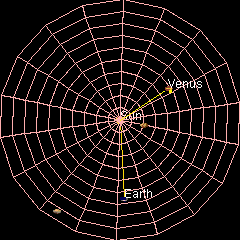Orbit of Venus
[1][2] The low eccentricity and comparatively small size of its orbit give Venus the least range in distance between perihelion and aphelion of the planets: 1.46 million km.In Galileo’s day the prevailing model of the universe was based on the assertion by the Greek astronomer Ptolemy almost 15 centuries earlier that all celestial objects revolve around Earth (see Ptolemaic system).Observation of the phases of Venus was inconsistent with this view but was consistent with the Polish astronomer Nicolaus Copernicus’s idea that the solar system is centered on the Sun.[14] Observations of transits of Venus across the Sun have played a major role in the history of astronomy in the determination of a more accurate value of the astronomical unit.An equation in Astronomical Algorithms that assumes an unperturbed elliptical orbit predicts the perihelion and aphelion times with an error of a few hours.[18] E. Myles Standish wrote Classical ephemerides over the past centuries have been based entirely upon optical observations: almost exclusively, meridian circle transit timings.


semi-major axiseccentricityperihelion and aphelionorbital speedTransit of VenusConjunction (astronomy)Spherical astronomyecliptic longitudeconjunctioninclinationinferior planetsolar transits of VenusMercurygravitational potentiallowest delta-vtransferphases of VenusParker Solar Probedust ring-cloudcircumstellar discproto-planetary discplanetary systemBibcodeWayback MachineOutline of VenusArachnoidAtmosphereDune fieldsFeaturesMapping of VenusAlpha RegioAsteria RegioBeta RegioOvda RegioTerraeAphrodite TerraIshtar TerraLada TerraMountainsvolcanoesAbeona MonsAkna MontesAnala MonsArtemis CoronaBaʽhet CoronaBoala CoronaCiuacoatl MonsFand MonsFotla CoronaGula MonsHeng-o CoronaIaso TholusIdunn MonsIrnini MonsJaszai PateraMaat MonsMaxwell MontesNightingale CoronaOnatah CoronaOzza MonsPavlova CoronaQuetzalpetlatl CoronaPancake domeRenpet MonsSacajawea PateraSachs PateraSapas MonsScalloped margin domeSiddons PateraSif MonsSkadi MonsTheia MonsUshas MonsZisa CoronaList of coronae on VenusPlainsplateausGuinevere PlanitiaLakshmi PlanumSedna PlanitiaCanyonsvalleysAikhulu ChasmaArtemis ChasmaBaltis VallisDali ChasmaDevana ChasmaDiana ChasmaGanis ChasmaCratersAddamsAdivarAgnesiAlcottAriadneAureliaBartonCleopatraCunitzDanilovaDe LalandeDickinsonGoeppert-MayerGolubkinaGrimkeGregoryGuilbertIsabellaJeanneMaria CelesteMarikoMeitnerMerit PtahMona LisaNanichiStefaniaWheatleyYablochkinaGeodynamicsGeologySurface featuresVenus snowVenusquakeAspectsPhasesTransits